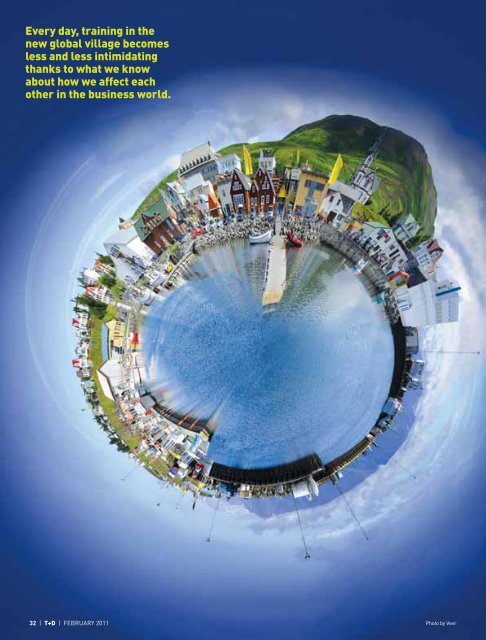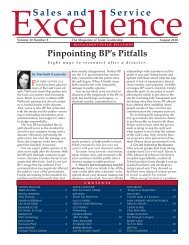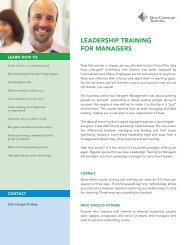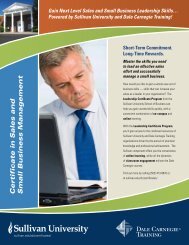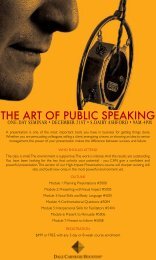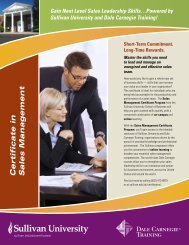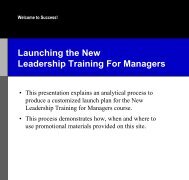to download document - Dale Carnegie Training
to download document - Dale Carnegie Training
to download document - Dale Carnegie Training
You also want an ePaper? Increase the reach of your titles
YUMPU automatically turns print PDFs into web optimized ePapers that Google loves.
Every day, training in thenew global village becomesless and less intimidatingthanks <strong>to</strong> what we knowabout how we affect eachother in the business world.32 | T+D | FEBRUARY 2011Pho<strong>to</strong> by Veer
Sphere of InfluenceBy Kevin J. SensenigThe cover of a recent U.S. business magazine posed thequestion: “Will your people follow your lead?” While thisis a good question for leaders <strong>to</strong> consider, it is also a powerfulquestion that we as trainers should ask ourselvesbecause our ultimate achievement rests in the ability <strong>to</strong>effectively influence decision makers and participants inthe organizations where we deliver training. Rather thanfocusing on our role and content, and trusting that ourparticipants will adjust <strong>to</strong> us, it is increasingly importantthat we establish an environment of inclusion and influence,particularly in international training programs.As people interact around a shrinking globe, both in person and electronically, theability <strong>to</strong> build and strengthen relationships right from the beginning is absolutely critical<strong>to</strong> the success of projects and organizations. Trainers who lack the ability <strong>to</strong> nurturerelationships or who are pressured <strong>to</strong> deliver immediate results without taking the time <strong>to</strong>establish a foundation of rapport, tend <strong>to</strong> be less productive in the long run. So how doesone build relationships, strengthen positive influence, and establish an environment ofinclusion when working with audiences around the globe?LISTEN TO THIS FEATUREat www.astd.org/TD/TDpodcasts.htmFEBRUARY 2011 | T+D | 33
Relationships firstIn his 1936 book, How <strong>to</strong> Win Friendsand Influence People, <strong>Dale</strong> <strong>Carnegie</strong>suggested three sets of principles <strong>to</strong>build productive relationships thatsupport an environment of inclusionand influence. These time-honoredprinciples can be successfully appliedin <strong>to</strong>day’s global business environment.Here is a brief overview of importantprinciples for building influenceand inclusion:1. Fundamental techniques forstrengthening relationships. Relationshipsbuilt on trust are thefoundation for successful influenceand inclusion. <strong>Carnegie</strong> identifiedprinciples that can help internationalbusinesspeople connect with theirglobal counterparts effectively <strong>to</strong> work<strong>to</strong>ward common goals. Principlessuch as “Become genuinely interestedin other people,” “Give honest andsincere appreciation,” and “Be a goodlistener; encourage others <strong>to</strong> talk aboutthemselves,” can be invaluable in establishingsuccessful relationships inperson or via technology.2. How <strong>to</strong> win people <strong>to</strong> your way ofthinking. These principles containadvice for influencing both individualand team action and cooperation.<strong>Carnegie</strong> demonstrated by examplehow a thorough understanding ofanother’s point of view is the basis forsuccessful collaboration. Principlessuch as “Show respect for the otherperson’s opinion,” and “Be sympatheticwith the other person’s ideas anddesires,” enable professionals <strong>to</strong> buildcooperation even in the most diversework groups.3. How <strong>to</strong> change people without givingoffense or arousing resentment.A leader who has established credibilityand earned trust can then influenceothers <strong>to</strong> make positive changes—without offending anyone. Principles34 | T+D | FEBRUARY 2011such as “Call attention <strong>to</strong> people’s mistakesindirectly,” “Let the other personsave face” and “Give the other person afine reputation <strong>to</strong> live up <strong>to</strong>” establishan environment where team membersand training participants can embracechange more readily because they feelthey are helping <strong>to</strong> build a new directionrather than being given a new approach<strong>to</strong> follow.While the principles make goodsense for leaders and trainers, it can bedifficult <strong>to</strong> incorporate many diverseopinions, especially if leaders or trainersfail <strong>to</strong> champion their own ideasand let their own contributions bewatered down. To garner more influencein a global environment, businessleaders and trainers need <strong>to</strong> shifttheir focus from diversity <strong>to</strong> inclusion.Rather than focusing on what makespeople different, leaders can achievethe most with others by exemplifyingthe common goal of the team and howeach team member can add value <strong>to</strong>the desired outcome based on theirunique contributions. Trainers, <strong>to</strong>o, canapply <strong>Carnegie</strong>’s principles <strong>to</strong> help participantsinteract effectively with theircounterparts from around the world.Global perspectiveson influence and inclusionWhen it comes <strong>to</strong> the interactionbetween team leaders and their teammembers, the expectations differ invarious cultures. It’s important fortrainers <strong>to</strong> understand these differencesand expectations in developingglobal leaders and in building influentialrelationships with trainees. Forexample, in many European and Asiancountries, trainers who display <strong>to</strong>o bigof a smile may be perceived as artificialand insincere. To effectively influencetraining participants, trainers need <strong>to</strong>adapt their emotions and approaches<strong>to</strong> be more in line with the audience,while helping the group <strong>to</strong> expand itscomfort zone and grow through thetraining experience.Although usually selected based onunique skills and experiences, goodteam leaders strive <strong>to</strong> include all theteam members’ perspectives. RatherWhen it comes <strong>to</strong> the interactionbetween teamleaders and their teammembers, the expectationsdiffer in variouscultures. It’s importantfor trainers <strong>to</strong> understandthese differencesand expectations indeveloping global leadersand in building influentialrelationships withtrainees.than asserting themselves (adoptingthe attitude “because I said so”), theymake the most of everyone’s contribution<strong>to</strong> create synergy while influencingthe team in the most productivedirection. To accomplish this, teamleaders have <strong>to</strong> be aware that teammembers from different countrieshave different norms and expectationsof how teams should function. Let’slook at the involvement and responsesof various players.Team leaders’ involvement. Perceptionsof a team leader’s role and levelof influence vary around the world. Forexample, in Eastern cultures (typically
found in parts of Asia and the MiddleEast), an individual’s position determineshis level of influence. In highlytraditional Eastern cultures, age and titlesignify experience and wisdom, andhence determine someone’s level of influence.Status, family, and educationlevel can also play a significant role.In these types of hierarchical workenvironments, superiors tend <strong>to</strong> setdirection using a parental or directivemodel. People are unlikely <strong>to</strong> disagreepublicly with someone who rankshigher in the organization. In the sameway, team members defer <strong>to</strong> the teamleader. They are accus<strong>to</strong>med <strong>to</strong> waitingfor the leader <strong>to</strong> state the direction andpropose an idea, and then the team’sapproach is <strong>to</strong> support the leader. Inthese cultures, a team leader or trainerhas <strong>to</strong> make a concerted effort <strong>to</strong> solicitand include everyone’s input whileappreciating their traditional view onsuch outward involvement.Team members’ involvement. Significantdifferences in team memberinvolvement may pose challenges <strong>to</strong>a leader seeking inclusion. In Westerncultures a team leader may setthe <strong>to</strong>ne and suggest a direction. Sheis used <strong>to</strong> a robust interaction amongactive team members with ideas beingchallenged openly. When leading across-regional team, it’s important <strong>to</strong>discard any preconceived notions onthe functioning of teams. As the teamgets <strong>to</strong> work, leaders need <strong>to</strong> remainaware of the level of everyone’s involvementand reach out <strong>to</strong> less activecontribu<strong>to</strong>rs. People whose culturedemands that they defer <strong>to</strong> the boss orteam leader may hold back until askeddirectly for an opinion.Once team leaders are confidentthat everyone has been included andthat they have built excellent relationshipswith every team member, theycan then proceed <strong>to</strong> influence theteam in the desired direction. Here,<strong>Dale</strong> <strong>Carnegie</strong>’s “Big Secret of Dealingwith People” comes in handy. Hewrites: “There is only one way underhigh heaven <strong>to</strong> get anybody <strong>to</strong> doanything. And that is by making theother person want <strong>to</strong> do it. The onlyway I can get you <strong>to</strong> do anything is bygiving you what you want.” And whatpeople want most is <strong>to</strong> be important,he argues. The applicable principlestherefore are, “Give honest and sincereappreciation” and “Arouse in the otherperson an eager want.”Team members’ responses. Howpeople respond <strong>to</strong> a stated idea presentsanother challenge <strong>to</strong> leaders whostrive <strong>to</strong> successfully influence teams.In more authoritative cultures, teammembers may place a positive spin ontheir disagreement that can be misinterpretedas full agreement. Leadershave <strong>to</strong> learn <strong>to</strong> listen for the intent ofthe response rather than taking it literally.In a global environment, activelistening is especially critical for leaders.It means listening for the meaningbehind a statement, listening for theintent of a response as well as “listening”<strong>to</strong> body language.For all of the focus on diversity andmulticulturalism, the Western worldtends <strong>to</strong> focus largely on differencesamong people and <strong>to</strong> work accordingly.In Eastern business cultures, professionalstend <strong>to</strong> be accus<strong>to</strong>med <strong>to</strong>working on teams made up of membersfrom many countries. They morequickly look at the common purposeof the team rather than the differencesin team members. I recently had theopportunity <strong>to</strong> work with a global client’stechnology lead group located inTaipei. The team, made up of membersfrom Taiwan, China, Brazil, andItaly, worked diligently on ways <strong>to</strong>improve their collaboration and accountabilitywith a focus on meetingFEBRUARY 2011 | T+D | 35o
Seven Principles for Effective InfluenceOf the many principles in <strong>Dale</strong> <strong>Carnegie</strong>’s book, How <strong>to</strong> Win Friends and InfluencePeople, here are some simple, yet highly effective pointers for leaders who want <strong>to</strong>build relationships and influence people in global business:• “Remember that a person’s name is <strong>to</strong> that person the sweetest and most importantsound in any language.” Learn how <strong>to</strong> pronounce people’s names accuratelyand remember their names, regardless of language difficulties. For example,address them by their real name, not an anglicized nickname. It builds immediaterapport, which is the prerequisite for influence.• “Make the other person feel important—and do it sincerely.” Learn certainphrases in the foreign language, such as hello, goodbye, please, thank you, wouldyou be so kind as <strong>to</strong> …, won’t you please, would you mind.• “The only way <strong>to</strong> get the best of an argument is <strong>to</strong> avoid it.” Particularly incultures where saving face is paramount, losing an argument can destroy rapportwith the “winner.” “You can’t win an argument,” writes Mr. <strong>Carnegie</strong>. “You can’tbecause if you lose it, you lose it; and if you win it, you lose it.” Why? Becausethe loser will now feel inferior and will resent any further attempts at influence.Regardless of culture, arguments are also futile because “Nine times out of 10,an argument ends with each of the contestants more firmly convinced than everthat he is absolutely right.”…”You may be right, dead right, as you speed alongin your argument; but as far as changing another’s mind is concerned, you willprobably be just as futile as if you were wrong.”• “Begin in a friendly way” is a timeless principle applicable <strong>to</strong> any culture, asdemonstrated by Aesop, who in one of his immortal fables wrote how the sun canmake you take off your coat more quickly than the wind. “Kindliness, the friendlyapproach and appreciation can make people change their minds more readilythan all the bluster and s<strong>to</strong>rming in the world,” writes <strong>Dale</strong> <strong>Carnegie</strong>.• “Let the other person feel that the idea is his or hers.” Again, this is a timeless,international principle, as demonstrated by the writings of Chinese sage Laotse,25 centuries ago: “The reason why rivers and seas receive the homage of ahundred mountain streams is that they keep below them. Thus they are able <strong>to</strong>reign over all the mountain streams.”• “Ask questions instead of giving direct orders.” Asking questions makes requestsmore palatable, stimulates the creativity of people, gives them a feeling of importance,and saves their pride. Say things such as, “Do you think this would work?”or “You might consider this.”• “Make the other person happy about doing the thing you suggest.” Here are sixspecific steps recommended by <strong>Dale</strong> <strong>Carnegie</strong>:1. Be sincere; concentrate on the benefits <strong>to</strong> the other person.2. Know exactly what it is you want the other person <strong>to</strong> do.3. Be empathetic. Ask yourself what it is the other person really wants.4. Consider the benefits that person will receive from doing what you suggest.5. Match those benefits <strong>to</strong> the other person’s wants.6. When you make your request, put it in a form that will convey <strong>to</strong> the otherperson the idea that he personally will benefit.A leader who is seen as proficient at hearing everyone, creating team synergy,and guiding teams <strong>to</strong>ward the best outcomes is highly respected in an internationalenvironment. By earning respect in this way and by being inclusive and using goodinfluence skills, a leader will be heard and followed.36 | T+D | FEBRUARY 2011Pho<strong>to</strong> by Veer
the increasing expectations on theteam. Little was made of the interestingmix of nationalities and culturesrepresented on the team.Contrast this with an opportunityI had <strong>to</strong> work with a North Americanfirm on a team that was much morehomogenous based on nationality andculture; yet, much of the team members’focus was on dealing with theirdifferences based on being located indifferent regions of the United States.Of course, neither of these organizationsis good or bad based on how theyview themselves.What we as trainers can learn fromthis is that inclusion is not a simplematter of looking at the group andidentifying participants’ differences; itis truly about understanding people’sperspectives on how they interact withone another on a daily basis.<strong>Training</strong> global employees<strong>Training</strong> and development professionalswho want <strong>to</strong> help businesspeoplefulfill their roles as global leaders need<strong>to</strong> have a heightened awareness ofcultural differences so they can be rolemodels in addition <strong>to</strong> trainers. Trainersneed a good grasp of the significantdifferences found between ethnicgroups within a single country.For instance, India has more than100 ethnic groups speaking more than29 major languages that may bringmany different expectations <strong>to</strong> theclassroom and the workplace. China,<strong>to</strong>o, has a mix of peoples of differentethnicities; Brazil has a significantinfluence of people from Europeandescent; and Egypt’s population is reallya blend of many different cultures,roots and religious beliefs. In Europe,people of northern and central Europeanancestries may be found in the sameclassroom as trainees who immigratedfrom Turkey, India, or Pakistan. It’s notenough <strong>to</strong> assume a given perspectiveof trainees based on the country inwhich the training will be delivered.The application of positive humanrelation principles <strong>to</strong> build influenceand inclusion is essential in all fivephases of solid international training:1. Analyze the need for training.When conducting a needs analysis,arrive at a thorough understandingof the cultural issues that may be atplay. Appreciate how participants fromdifferent regions may portray theirtraining needs, and apply multipleanalytical approaches <strong>to</strong> uncover theirtrue needs.2. Design the training. Appreciatedifferences in learning expectationsin different regions. Are participantsaccus<strong>to</strong>med <strong>to</strong> a highly participantinteractive delivery style, or do theyview trainers like bosses—experts ormasters rather than facilita<strong>to</strong>rs? Aretrainees careful in voicing opinions inthe presence of colleagues or superiorsin the class? These issues must be consideredin the training design.3. Develop the training. Ensure thatmaterials and visual aids are inclusiveof global participants. Incorporate avariety of examples that are relevant <strong>to</strong>the audience without being so demographicallyspecific that materials becomecliché. Build diverse perspectivesand representation throughout thematerials so all participants can connectin meaningful ways. Use regionallyapplicable case studies and examples.4. Implement the training. Effectivetrainer-participant interactiondepends on the trainer’s awarenessof the cultural issues in a particularregion. Know the trainees’ communicationstyles so everyone’s inputcan be heard. Trainers who are trulyparticipant-focused can build levels ofinfluence and inclusion in every trainingenvironment.<strong>Training</strong> and developmentprofessionalswho want <strong>to</strong> help businesspeoplefulfill theirroles as global leadersneed <strong>to</strong> have a heightenedawareness ofcultural differences sothey can be role modelsin addition <strong>to</strong> trainers.Trainers need a goodgrasp of the significantdifferences found betweenethnic groupswithin a single country.FEBRUARY 2011 | T+D | 37
oIf we can expertly5. Evaluate the training. Culturalconsiderations can cause tremendousvariation in the ratings trainers willreceive from one country <strong>to</strong> another.In some cultures, trainees never giveextremely high or low marks on anevaluation form. For example, in someAsian and Middle Eastern cultures, arating of three <strong>to</strong> four may mean thetrainer did an outstanding job worthyof a perfect five in North America. Usemultiple feedback <strong>to</strong>ols <strong>to</strong> assure thetraining is being effectively evaluatedacross the global participant group.Set an exampleSome countries still view cultural differencesas a problem rather than anopportunity. Others are beginning <strong>to</strong>embrace diversity, and still others aretaking it <strong>to</strong> the next level of inclusion.Regardless of the region in which weas trainers work, we are going <strong>to</strong> beviewed as role models, good or bad. Ifwe can expertly demonstrate a spirit ofinclusion as we design, develop, andimplement programs for internationalaudiences, our trainees will follow ourexample and become more effective,inclusive global businesspeople.Further, if we as trainers demonstratesuperb influence skills, our participantswill emulate those behaviorsand become better at setting directionfor others on their team basedon enhanced levels of influence andinclusion. It is up <strong>to</strong> us in the trainingprofession <strong>to</strong> set the standard high forpositive influence in an internationalbusiness environment.Kevin J. Sensenig is the global vice presiden<strong>to</strong>f learning & organization developmentwith <strong>Dale</strong> <strong>Carnegie</strong> & Associates, aperformance-based training company withoffices in more than 75 countries worldwide;kevin.sensenig@dalecarnegie.com.demonstrate a spirit ofinclusion as we design,develop, and implementprograms for internationalaudiences, ourtrainees will follow ourexample and becomemore effective, inclusiveglobal businesspeople.INTERESTED IN ORDERING E-PRINTS?Would a digital version of this article be a greatfit for your next course, presentation, or event?Are you interested in e-prints of several T+Darticles on a specific <strong>to</strong>pic?Visit astd.org/TD/eprints for more information.Pho<strong>to</strong> by Veer38 | T+D | FEBRUARY 2011
TRAINING + DEVELOPMENTYES!I would like <strong>to</strong> subscribe <strong>to</strong> T+D magazine—12 monthly issuesthat keep me at the forefront of workplace learning and performance.r Individual rate $150 ($216 outside the U.S.)r Institutional rate $300 ($366 outside the U.S.)Order InformationName:_______________________________________________________________________TD0833Title:_ ________________________________________ Company:_______________________________Address:______________________________________ City:____________________________________State/Province:_________________________________ Zip/Postal Code:__________________________Country:______________________________________ Email:___________________________________Phone:_______________________________________ Fax:____________________________________Check One: $150 (Individual USA) $216 (Individual Outside the US)$300 (Institutional USA) $366 (Institutional Outside the US)VISA MasterCard Amex Discover Check (USD)(Payable <strong>to</strong> T+D)Card Number:_________________________________ Expiration Date:__________________________Signature:_____________________________________________________________________________Fax this form <strong>to</strong> 1.205.995.1588 OR Mail <strong>to</strong>:American Society for <strong>Training</strong> & DevelopmentSubscription Office, P.O. Box 11806Birmingham, Alabama 35202-1806, USAOrder online at s<strong>to</strong>re.astd.orgPhone: 1.866.802.7059Orders processed within three business days.If you have questions, please contact td@subscriptionoffice.comPrices valid through 12/31/2010. If you should wish <strong>to</strong> cancel your subscription for any reason,you will receive a refund on all unmailed issues. Your subscription <strong>to</strong> T+D may be a tax deductiblebusiness expense. Please allow 6 <strong>to</strong> 8 weeks <strong>to</strong> receive your first issue.090938.63250T+D is published by the American Society for <strong>Training</strong> and Development (ASTD)


